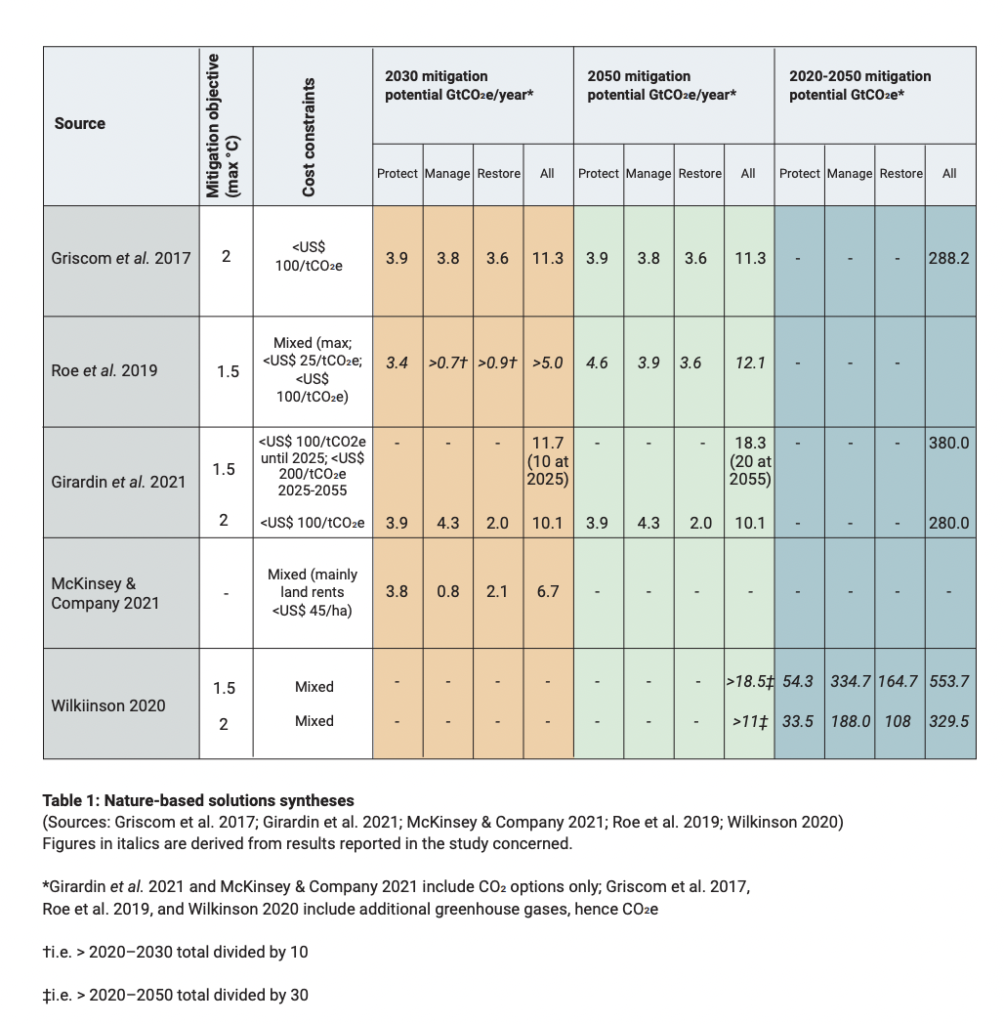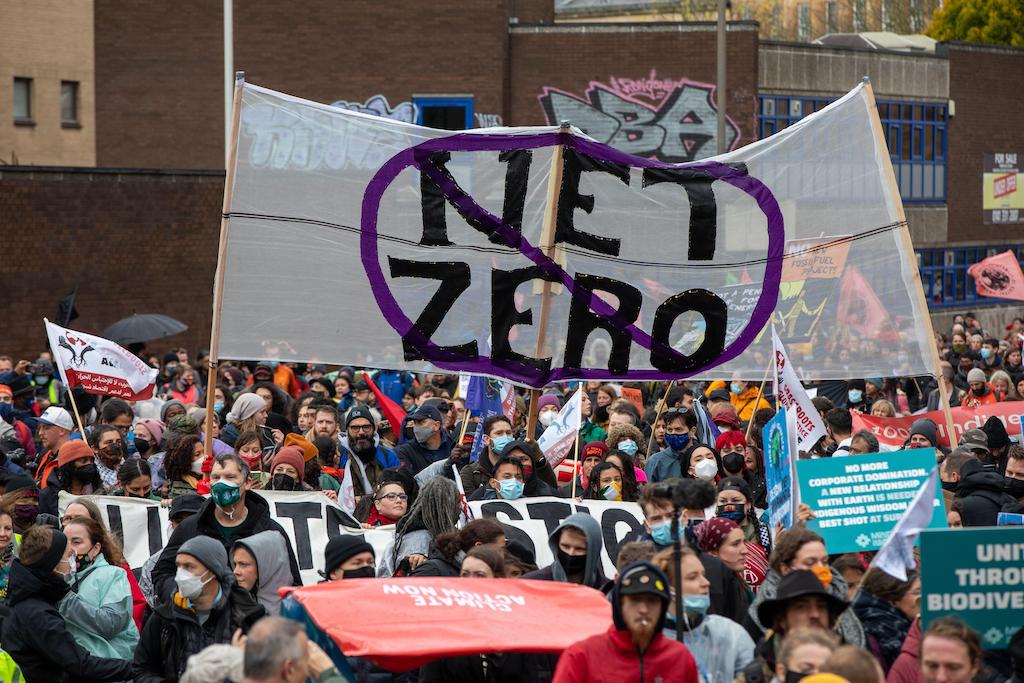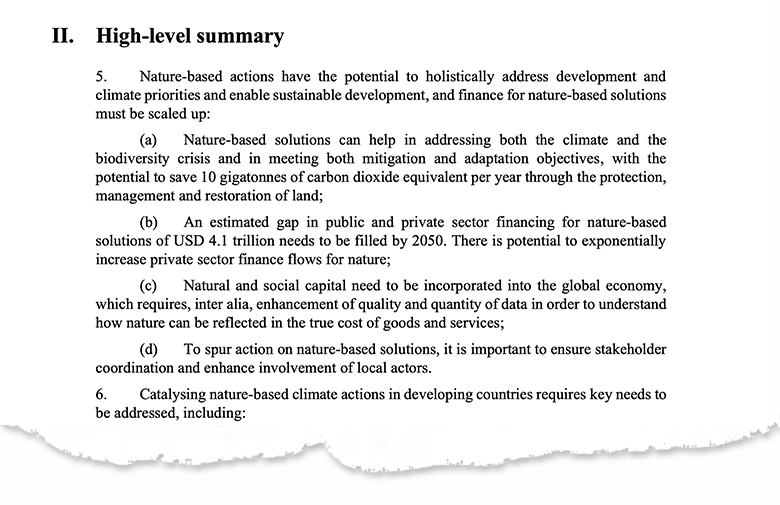
Q&A: Can ‘nature-based solutions’ help address climate change?
Multiple Authors
12.01.21Multiple Authors
01.12.2021 | 2:09pmIn recent years, the use of nature and natural ecosystems to mitigate and adapt to climate change has come to the forefront of discussions around meeting the goals of the Paris Agreement.
These so-called “nature-based solutions” are key to many countries’ and companies’ plans to achieve net-zero in the coming decades.
Nature-based solutions also featured more prominently than before at the UN’s COP26 climate summit in Glasgow last month. The term briefly made an appearance in a draft of what became the Glasgow Climate Pact and, following UK prime minister Boris Johnson’s mantra of “coal, cars, cash and trees”, countries at the summit made several headline-grabbing pledges aimed at halting deforestation.
But these “nature-based solutions” are not without their critics. Some argue that the very concept of nature as a tool reduces and obscures its inherent value. Others reject the term and warn that its vagueness leaves it open to deliberate misuse.
In this explainer, Carbon Brief examines the history of the term “nature-based solutions”, the debates surrounding their effectiveness and the place they currently hold in global climate negotiations.
- What is the origin of the term ‘nature-based solutions’?
- How much CO2 could nature-based solutions save?
- How could nature-based solutions benefit adaptation?
- Why are some critical of the term ‘nature-based solutions’?
- How do nature-based solutions fit into national and international climate policy?
- How much money is being spent on nature-based solutions?
- Case study: How are nature-based solutions being used in Australia?
What is the origin of the term ‘nature-based solutions’?
The term “nature-based solutions” was coined by the World Bank in 2008 and adopted that same year by the International Union for the Conservation of Nature (IUCN). The IUCN defines nature-based solutions as:
“Actions to protect, sustainably manage and restore natural and modified ecosystems in ways that address societal challenges effectively and adaptively, to provide both human well-being and biodiversity benefits. They are underpinned by benefits that flow from healthy ecosystems and target major challenges like climate change, disaster risk reduction, food and water security, health and are critical to economic development.”
In its original usage, the term predominantly referred to ways of working with nature for the purposes of climate change adaptation and biodiversity conservation. It is only “quite recently” that the discussion around nature-based solutions has shifted more towards using them to mitigate climate change, says Prof Nathalie Seddon, the director of the Nature-based Solutions Initiative at the University of Oxford.
Another term that has been suggested is “natural climate solutions”, although these primarily focus on the climate-based benefits of protecting nature.
Nature-based solutions work by either increasing carbon storage, such as by planting more trees, or by avoiding greenhouse gas emissions, such as by limiting deforestation. Seddon and others often separate the solutions into three broad categories:
- Ecosystem conservation
- Ecosystem restoration
- Improving land management practises
Ecosystem conservation, or protection, is aimed at stopping the loss of carbon from soils, forests or the ocean. Some examples are halting deforestation in tropical rainforests and creating or expanding protected areas.
Ecosystem restoration involves the rehabilitation of already-degraded biomes, such as rewetting peatlands and restoring coastal ecosystems including seagrass meadows and mangroves. This category also contains solutions that rely on the construction of entirely new ecosystems, such as large-scale tree-planting or the creation of manufactured wetlands.
Improved land management practises include switching away from industrial farming to more sustainable methods – such as agroecology or agroforestry, increasing soil carbon content through the use of cover crops, and promoting soil health by lessening the amount of chemical fertilisers applied to land.
Nature-based solutions are often ways that land can be used to take up or store more carbon, but there is a growing recognition that the ocean can play a vital role in this, too, Seddon adds. She tells Carbon Brief:
“What happens in the ocean, what happens along our coast, is critically important in the context of climate change. And so we don’t want to overlook that.”
How much CO2 could nature-based solutions save?
Using integrated assessment models, researchers can estimate just how much “mitigation potential” nature-based solutions have. Several studies put that number at around 10-12bn tonnes of CO2 equivalent (GtCO2e) per year – enough to reduce peak warming by about 0.3C, Seddon says.
These estimates vary, though. A 2017 study published in the Proceedings of the National Academy of Sciences set the “drawdown potential” of nature-based solutions at 23.8GtCO2e per year – although that study notes that, of this potential, only 11.3GtCO2e per year is cost-effective.
A recent report by the IUCN and the UN Environment Programme (pdf) summarises the major studies into the mitigation potential of nature-based solutions. The table below – taken from the report – shows that, by 2030, nature-based solutions across all land-based ecosystems could result in removals of at least 5GtCO2e per year, going up to 11.7GtCO2e. By 2050, this could be between 10-18GtCO2e per year, the report says.

However, the wide range of estimates from different studies and their different approaches make them difficult to compare directly. This means the potential of different interventions cannot always be added up neatly if calculated separately, as solutions might compete for land and other resources.
Regardless of the true figure, a large gap remains between the amount of CO2 being emitted – around 40GtCO2 per year from fossil fuel burning and land-use change – and the amount of CO2 that nature-based solutions can draw down. “It’s quite a lot, but it’s a lot less than what we need to do,” says Seddon.
A recent Nature comment that Seddon co-authored breaks down the mitigation potential of each of the three categories of solutions. Of an estimated 10GtCO2e total, only 20% of the potential arises from restoring degraded ecosystems, including by “afforestation”, or tree planting. Protecting existing ecosystems and sustainable land management each contribute 40%. Seddon tells Carbon Brief:
“This focus on tree-planting can distract from the primary need, first of all, to protect what ecosystems we’ve got left.”
In 2019, the Intergovernmental Panel on Climate Change (IPCC) published a special report on climate change and land, known as the SRCCL, as part of its sixth assessment cycle. It estimates that agriculture, forestry and land-use change contribute to nearly a quarter of total net human-caused emissions of greenhouse gases.
The SRCCL assessed the land-based actions that are already being taken that contribute to climate change adaptation, mitigation and sustainable development. It found that “sustainable food production, improved and sustainable forest management, soil organic carbon management, ecosystem conservation and land restoration, reduced deforestation and degradation, and reduced food loss and waste” are the options that best met all these challenges, but they “require integration of biophysical, socioeconomic and other enabling factors”.
The report also lists a range of different mitigation strategies and estimates by each of these land management solutions. According to the report, the actions with the largest potential for reducing land-use emissions are reduced deforestation and forest degradation (0.4-5.8GtCO2e per year), a shift towards plant-based diets (0.7-8.0GtCO2e per year) and reduced food and agricultural waste (0.8-4.5GtCO2e per year).
Meanwhile, it says, the solutions with largest potential for CO2 removal are afforestation (0.5-10.1GtCO2e per year), sequestration of soil carbon in croplands and grasslands (0.4-8.6GtCO2e per year) and bioenergy with carbon capture and storage (BECCS) (0.4-11.3GtCO2e per year).
Carbon Brief has previously analysed a range of different natural climate solutions and found that they could provide a sizable portion of the required emissions reductions needed in pathways to below 1.5C, limiting the need for BECCS. This is particularly when coupled with faster emissions reductions over the next few decades.
One of the key cautions of the SRCCL is that some of these solutions could increase the demand for land, leading to “adverse side effects for adaptation, desertification, land degradation and food security”.
However, solutions such as improved management of cropland and grazing lands, improved and sustainable forest management, and increased soil organic carbon content do not require land-use change. Preserving and restoring high-carbon natural ecosystems and biodiversity conservation can reduce competition for land while contributing to sustainable development and enhance ecosystem functions while reducing poverty, if done right.
Time-wise, the conservation of high-carbon ecosystems – such as peatlands, wetlands, rangelands, mangroves and forests – yields the quickest results, says the IPCC report. On the other hand, afforestation, reforestation and restoration, agroforestry and reclaiming degraded soils can take decades to deliver.
Carbon sequestration in soil or vegetation through afforestation, agroforestry or storage in harvested wood is also not everlasting. Trees mature and reach peak carbon offtake, soil carbon can reach saturation, climate change can reduce the ability of vegetation to absorb more carbon and entire forests can burn in climate change-induced wildfires.
Meanwhile, peatlands can continue to sequester carbon for centuries. But neither of these natural carbon reserves are immune from future human influence or climate change-induced extreme weather. For example, research has shown how tropical forests are at risk of becoming sources of carbon in future – particularly if warming exceeds 2C.
How could nature-based solutions benefit adaptation?
To proponents of the concept of “nature-based solutions”, the term brings “nature” and biodiversity back into a discussion around mitigation and adaptation techniques that has often been dominated by a discourse centred on fossil-fuel emissions and energy choices.
These advocates point out the ability of natural landscapes to both store carbon from the atmosphere on decade- to century-long timescales and to help humans withstand climate impacts.
Although the recent political focus on nature-based solutions has concentrated on using them as a way to mitigate climate change, nature-based solutions for adaptation remain vitally important, says Xiaoting Hou-Jones, a senior researcher at the International Institute for Environment and Development. She tells Carbon Brief:
“The ecosystem services that healthy or thriving nature provides are really fundamental for our resilience to climate change impacts. And the degradation of nature, then fed by climate change…creates this vicious circle we’ve seen in many of the more vulnerable regions [of the world].”
Furthermore, Hou-Jones says, solutions for mitigation must take climate resilience into account in order to be effective. For example, if trees are planted in a wildfire-prone area, only to burn the following year, all of that carbon would be released back into the atmosphere.
Some nature-based solutions address mitigation and adaptation at the same time. Mangroves store massive amounts of carbon, but they can also act as bulwarks against storm surges. Urban trees draw down CO2 from the atmosphere, but they also provide shade and cooling effects.

A study that Seddon and her colleagues published in Global Change Biology analysed and mapped the effectiveness of nature-based solutions focused on climate change mitigation.
They found that most of the solutions involving intact or semi-natural ecosystems “ameliorated adverse climate impacts”, but solutions that involved creating entirely new ecosystems – such as afforestation projects – had to take into account trade-offs, such as land and water availability.
Even though the global south is more severely impacted by climate change, the study found that there was a bias in the literature towards nature-based solutions for adaptation, or “interventions”, that have been implemented in the global north. Nearly 80% of the interventions identified in the academic literature were carried out in the global north, as compared to only 15% in lower- and middle-income countries in the global south.
But, despite the bias in the formal literature, Seddon says there is an “enormous amount of understanding” about working with nature for adaptation in the global south. She adds:
“In fact, I would say most of the deeper understanding about how to work with ecosystems comes from the communities that have been having to deal with climatic variability and natural disasters for a very long time – communities in Bangladesh, for example, that are right at the front line of climate change.”
The fact that climate change and biodiversity loss share many of the same root causes means that some solutions can address both at once, such as by preserving ecosystems that both store carbon and house native species.
Hou-Jones tells Carbon Brief:
“Inequality and nature and climate change – all these three challenges we see on the ground exacerbate each other. You can’t go to a place where these three things can be easily untangled…For whatever nature-based solution to work, you need to tackle those three challenges together.”
However, nature-based solutions vary in their effectiveness for both mitigation and adaptation. Although afforestation has garnered lots of attention over the past several years, several studies have shown that large-scale tree planting projects do little to improve tree cover, biodiversity or peoples’ livelihoods.
Seddon makes it clear that planting trees – or any other nature-based solution – is no “silver bullet” for climate change. She tells Carbon Brief:
“The primary need is to keep fossil fuels in the ground. It is very worrying that high-emitting industries and high-emitting countries are indicating that somehow if we grow enough trees we will be able to offset our emissions. That’s impossible to do.”
(For more on the negative emissions potential of different nature-based solutions, see Carbon Brief’s explainer on the topic.)
Why are some critical of the term ‘nature-based solutions’?
The term “nature-based solutions” in itself has not been universally welcomed. Its critics – including academics, environmental activists, non-governmental organisations and civil society groups – argue that nature-based solutions do not substantially address climate change and can even be harmful to both the environment and humans.
One issue, these critics say, is that the term “nature-based solutions” is a vaguely defined catch-all term, with no clarity on what “nature” is or what solutions are natural.
All nature-based solutions involve some degree of intervention in complex socio-ecological systems, but they differ in the degree to which they do so and in which management approach they use or adopt.
It is unclear what degree of technological intervention or human management allows a solution to be categorised as a nature-based solution, says Teresa Anderson, a climate policy coordinator at the non-governmental organisation ActionAid International. She tells Carbon Brief:
“Any rubbish can be branded as nature-based nowadays. The term can be used to apply to tree plantations, industrial agriculture, land grabs, carbon offsets, biodiversity offsets. The term is so vague I could probably cut down a tree, whittle it down to a stick, wave it at the moon and call it a nature-based solution.”
Another criticism is that the emphasis on the word “solutions” – in a similar way to the term “ecosystem services” – implies that nature is only beneficial in its utility to humans, not necessarily for its own sake. This point was made strenuously by the Bolivian delegation at COP26.
#COP26 Bolivia slams the cover text. “This text assumes that nature is only in service of people’s needs, but nature has an intrinsic value. It is sacred. That must be reflected. ‘Nature-based Solutions’ was never negotiated here”
— nathan thanki (@n_thanki) November 10, 2021
The vague definition of nature-based solutions means it is also at risk from the deliberate and non-deliberate misuse, Anderson says. This has allowed the idea to be co-opted by actors with little interest in making structural change, she tells Carbon Brief:
“When the term first appeared, some of us really had high hopes that nature-based solutions were going to prove to be a really useful term to centre biodiversity protection as a key climate strategy.”
Instead, she says, the “lack of clear definitions and principles” has meant the term can be applied to a whole suite of potential actions that may or may not have real benefits for the climate or biodiversity.
Anderson adds that the term is now “almost universally synonymous with carbon offsetting”. She says:
“Most of these [net-zero pledges] have huge ‘negative emissions’ components – the assumption that something, somewhere is going to suck the carbon out of the air after they’ve polluted it…We increasingly see that the most prominent advocates of nature-based solutions tend to be the polluters because they see it as a solution to their pollution.”
In some cases, the negative emissions contributions of nature in these pledges are based on wholly unrealistic assumptions about land use and availability, continues Anderson. This means that those making the pledges will end up resorting to land grabs, leading to the violation of Indigenous peoples’ rights, she says.

Anderson points out that the communities where tree plantations are planned are “the ones who have done the least” to cause climate change. Nor are these communities the ones calling for these strategies, she says.
The term nature-based solutions “means what the powerful actors using it to green their images want it to mean”, writes Prof Doreen Stabinsky, professor of global environmental politics at the College of the Atlantic in the US and advisor to a group of developing country governments on the issue of loss and damage.
In a recent publication, Stabinsky says that academics might “write long peer-reviewed articles laying out criteria by which so-called [nature-based solutions] might be evaluated whilst oil majors create new ‘nature-based solutions’”, unaligned with these criteria and units. She tells Carbon Brief:
“That term is the Wizard of Oz curtain. Jousting with the term is not the battle to be fought. What’s behind that curtain? And who are the actors using the term nature-based solutions? The biggest threat is nature as offset. Its high offsetting value becomes the primary reason for nature to exist: not because it’s nature, not because it has its own inherent value or is valuable for people’s livelihoods.”
Oil-major Shell, for instance, defines nature-based solutions as:
“Projects which protect, transform or restore land. In this way, nature absorbs more CO2 emissions from the atmosphere. These projects can lead to the marketing, trading and sale of carbon credits.”
According to Shell, these “can make a big contribution to our ambition to be a net-zero emissions energy business by 2050, or sooner” and “have a role to play in reducing the carbon intensity of the energy products we sell”.
Hou-Jones agrees that there are “really good, genuine concerns” about nature-based solutions, including their use as a “greenwashing” tool and the removal of Indigenous voices from the conversation.
She points to guidelines (pdf) published by the IUCN for the design of successful nature-based solutions, which include that participation in the solutions should be “based on mutual respect and equality, regardless of gender, age or social status, and uphol[d] the right of Indigenous peoples to free prior and informed consent”.
Rather than getting “hung up” on the specific terminology used to describe solutions as a whole, people should critically assess nature-based solutions on a case-by-case basis, Hou-Jones says. She explains:
“Whatever we call them, we want to make sure that they’re good for nature, good for people and good for climate change…Instead of arguing which terminology we use, we really advocate for people to look at and really scrutinise how those nature-based solutions are implemented.”
The term also runs the risk of oversimplifying what it takes to reduce land carbon emissions, removing people and politics from the equation.
Prof Forrest Fleischman, a forestry expert at the University of Minnesota, points out that while nature plays an important role in the carbon cycle, human damage to the natural world is a major source of emissions. He says that nature-based climate change should just be called what it is: land-use change. He tells Carbon Brief:
“Nature-based solutions is a bad term, because it’s really about people. It’s not about nature. It disguises who’s making the change: Oh, we’ll just let nature do it. But if human land use is a cause of climate change, then to change that we need to change how humans interact with our land. We need people-centred climate solutions.”
How do nature-based solutions fit into national and international climate policy?
Actions that fall within the broad basket of “nature-based solutions” play a key role in many countries’ plans to adapt to and mitigate climate change.
A 2020 analysis published in the journal Global Sustainability examined the language around nature-based solutions in the 168 original nationally determined contributions (NDCs), or climate pledges, submitted by countries to the UN Framework Convention on Climate Change (UNFCCC) under the Paris Agreement.
The authors found that nearly two-thirds of the signatories to the Paris Agreement included “nature-based solutions” in their climate adaptation and mitigation plans. Of the 168 NDCs, 77 nations included “nature-based” actions for both adaptation and mitigation, 27 nations included actions for adaptation only and 27 nations included actions for mitigation only.
However, the paper notes, “national intentions to deliver [nature-based solutions] for climate change adaptation vary…and rarely translate into measurable evidence-based actions and targets”.
Nature is widely referenced in different parts of international climate texts. The emissions and removals of natural “sinks” and “sources” are typically accounted for as part of land, land-use change and forestry (LULUCF) emissions. Countries have to report on them as part of their national greenhouse gas inventories submitted to the UNFCCC, and the IPCC lays out guidelines for countries to measure and monitor these emissions.
However, countries are free to set their own baselines and reference levels, which has had problematic implications in the past and makes room for creative carbon accounting in how they report emissions from land-use change.
The preamble to the Paris Agreement reads, in part:

In the context of the Paris Agreement, the term ”nature-based solutions” has never been explicitly used and – as the Bolivian delegation pointed out at COP26 (see tweet above) – was never negotiated. Nevertheless, there are various ways that the international climate regime invokes or relates to what some refer to as nature-based solutions.
Reducing deforestation and forest degradation under the UN scheme REDD+ finds a home under Article 5 of the agreement. Just two paragraphs long, Article 5 accommodates decades of environmental and climate governance that preceded the Paris Agreement and decisions by parties regarding how forests are measured, monitored and mechanisms to pay to keep them standing. It states:

Article 5 spells out the UNFCCC’s framework to sustainably reduce emissions from deforestation and forest degradation (REDD+) in developing countries. Evolving from a decision at COP19 in Warsaw, REDD+ lays out how developing countries can receive payments from developed countries based on successful measures to protect forests and the carbon they contain.
Some 56 countries, accounting for more than 70% of the world’s natural forest cover, chose to include REDD+ strategies in their first NDCs, earlier research found.
Article 6 of the Paris Agreement, which relates to international climate cooperation via market and non-market approaches, could also involve nature-based solutions.
Broadly, Article 6 looks at international cooperation including carbon markets as a path to raising climate ambition. It puts forward three mechanisms to do this, whose rules were hotly debated until being finally agreed at COP26, after four years of negotiations.
Under Article 6.2, countries that overachieve the targets in their climate pledges – which could be a nature-based target such as forest cover – could sell (pdf) their surplus to countries failing to meet their own climate goals. This is through the use of “internationally transferred mitigation outcomes” or ITMOs.
Article 6.4 creates an international carbon market, where emissions reductions can be traded by the public or private sector. The methodologies under which these carbon credits could be generated are yet to be agreed, but they could potentially include certain nature-based solutions.
Finally, under Article 6.8, countries can cooperate towards achieving their climate goals through non-market measures, such as via developmental aid.
(For more information on Article 6, see Carbon Brief’s in-depth Q&A published in 2019. To catch up on COP26 outcomes, see Carbon Brief’s detailed round-up pieces here and here).
The Article 6.4 carbon market will be known as the Sustainable Development Mechanism (SDM), which replaces the Clean Development Mechanism (CDM) under the earlier Kyoto Protocol.
The SDM both builds on and differs from its predecessor in many ways.
For one, CDM was designed as an offsetting mechanism, which limited its goal to shifting the location of emission reductions rather than reducing overall emissions. For example, instead of a developed country reducing emissions at home, this could have been offset by creating a new forest in a developing country, which, under the Kyoto Protocol, did not have climate targets of its own.
Under the Paris Agreement, by contrast, all parties are expected to make and implement climate commitments. The SDM also adds a more specific goal to “deliver an overall mitigation in global emissions”. Its wording suggests that all countries will be able to generate and use units towards their climate pledges.
The SDM still retains a number of CDM features: for instance, setting aside a “share of proceeds” to cover administrative costs and to help finance adaptation in developing countries.

At the same time, the core tenets of carbon markets remain unchanged. SDM credits will be generated on a “per tonne of carbon abated” basis. This prompts players to pursue projects that offer the lowest prices for the highest abatement to ensure efficiency, without necessarily considering co-benefits of nature-based solutions unrelated to carbon emissions, such as biodiversity.Moreover, while carbon pricing and metrics might make sense in an ideal world, many biodiverse, less-developed parts of the world suffer from a lack of data. This means there are questions over the amount of carbon that could be sequestered by natural climate solutions in these regions and how these sinks would be affected by climate change, as well as agency, justice and equity questions in how data is gathered.
Fleischman tells Carbon Brief:
“It remains expensive and difficult to do accurate carbon estimations in natural ecosystems. It’s gotten a little cheaper: a lot of the investment that was put into REDD+ over the last decade or so was not put into actual carbon storage, but into what’s called monitoring, reporting and verification, or the ability of poor countries to monitor their forests. I think the problem with this is obvious: we’ve spent a whole bunch of money on things that don’t store carbon, just on our ability to measure carbon storage.
There are other ways to think about developing policies that would enable us to store carbon that don’t incur this large monitoring cost: giving local communities greater decision-making authority over their land, tends to increase, on average, the quality of the forest.”
At the same time, per tonne-carbon credits do not reflect the wide range of benefits to ecosystems or communities, says Gilles Dufrasne of the non-governmental organisation Carbon Market Watch. He tells Carbon Brief:
“Just by shifting away from this logic of per-tonne compensation, you just open up the universe of possible projects a lot more. And you can finance projects with high-integrity that have more benefits for the local communities that don’t maybe even deliver direct emissions reductions today. Like research or like an experimental nature-based solutions project where you’re not quite sure what the impacts are going to be.”
So, where do nature-based solutions fit within Article 6?
Some parts of the answer to this are clearer from negotiations that concluded in Glasgow last month, although the real test will be in how parties read the newly-finalised Paris rulebook.
Nature-based solutions were not initially “the talk of the town” in Article 6 negotiations at COP26, says Dufrasne, which were still at a “higher level”, negotiating accounting rules rather than “project types” or “solutions”.
These “fights” range from how to ensure that a tonne of CO2 is accounted for by only one entity in their climate pledges – avoiding “double counting” – and how to deal with credits from the past, established under the Kyoto Protocol. Dufrasne tells Carbon Brief:
“Carbon markets for nature-based solutions, in a way, had been surprisingly left out of the Article 6 negotiations until the end of COP26. It’s still a bit of the elephant in the room because the voluntary market is really booming with a focus on each of these solutions, especially avoided deforestation credits. And there’s a whole discussion around whether [CO2] removal should be favoured over [emissions] reductions.”
An SDM supervisory body is tasked with developing and approving methodologies for use under Article 6.4 and it remains to be seen if and how nature-based solutions will feature.

One of the earlier drafts of Article 6 rules drew ire from Indigenous and human rights groups, who noted the absence of references to human rights, free prior informed consent (FPIC) and the setting up of an independent grievance mechanism for carbon-offsetting projects. Eventually, the request for a grievance process was met.
However, FPIC and references to human rights in the design of carbon market activities were not included, sparking fears that this could lead to forced evictions of already marginalised Indigenous communities, faced with the worst impacts of warming.
At a press-conference hosted at COP26 by the Climate Vulnerable Forum, Mapuche leader Calfin Lafkenche of Minga Indigena reiterated that FPIC had to be included in negotiating text specifically around carbon markets. Countries were negotiating decisions around lands and resources without the previous consent of Indigenous peoples who live in those territories, said Lafkenche, who added:
“Every day, Indigenous people are murdered and it is us, with our resistance, assisting humanity…Until today, we haven’t changed colonial processes. We conserve 70% of the world’s biodiversity, we know not everything can be valued. Mother Earth, the waters, the lands: this is part of our spirituality, not something you can transact. You can’t transact the lives of your fathers, your children or your brothers. Because you are imprisoned in this building, you are forgetting what the kids and the people outside are fighting for.”
Meanwhile, REDD+ did hold up the final decision at COP26. Papua New Guinea reportedly led an ultimately unsuccessful bid to automatically include old REDD+ credits generated between 2015-2021 in the Article 6.2 mechanism.
Along with the Coalition for Rainforest Nations, Papua New Guinea was pushing text contained in early drafts – but not the final decision – that would also have fast-tracked the entry of new REDD+ credits generated under the scheme.
However, new REDD+ credits generated from this year onwards could still be used, if they meet wider Article 6 rules. Their use under Article 6.2 would be at the discretion of the countries involved and only subject to oversight some time later.
Nature-based solutions did make a brief cameo in the draft text that became the Glasgow Climate Pact. Language in the first draft emphasised the “critical importance of nature-based solutions and ecosystem-based approaches”, but included only forests and their role in “reducing emissions, enhancing removals and protecting biodiversity”.
In the end, the pact also recognised “other terrestrial and marine ecosystems” and their role in adaptation, while axing “nature-based solutions” in favour of “conserving and restoring nature and ecosystems”.
(For a full snapshot of how language around nature-based solutions evolved at COP26, see Carbon Brief’s explainer on key land use, food and nature outcomes.)
How much money is being spent on nature-based solutions?
From billionaire Jeff Bezos’ Earth Fund for the Amazon to a recent $12bn pledge in public finance for ending deforestation announced at COP26, finance for nature and biodiversity has recently been making headlines. Finance for nature is a fraction of the overall sums for climate finance, but is not insignificant.
According to the recent State of Finance for Nature report by the UN Environment Programme (UNEP), finance for nature-based solutions “ought to at least triple in real terms by 2030 and increase four-fold by 2050” relative to 2020 levels, if the world is to meet its climate, biodiversity and land degradation targets.
This would amount to a total investment of $8.1tn over 30 years, with forest-based solutions alone needing $203bn per year, peatland restoration $7bn per year and mangrove restoration $0.5bn.
The report says nature-based solutions currently receive $133bn in funding each year. This amount may seem substantial, given that developed countries have struggled to fulfill their annual $100bn climate finance commitments.
However, this sum is largely accounted for by what all governments spend domestically on afforestation, sustainable forestry and biodiversity conservation. At $115bn, public funds counted towards 86% of finance for nature-based solutions, including sources such as multilateral climate funds (e.g. the Green Climate Fund), national and bilateral finance, development finance institutions and subsidies.
Of the public finance, national governments tended to invest around one-third in biodiversity protection and two-thirds on restoration, regenerative agriculture, water conservation and natural pollution control solutions, the report says.
Private finance includes everything from biodiversity offsets and sustainable supply chains – for products, such as palm oil – to philanthropies, conservation non-governmental organisations and private equity impact investment. In all, it amounts to $18bn per year, the report estimates, accounting for only 14% of total finance for nature-based solutions.
In contrast, private-sector investments contribute to nearly half of the capital flows in climate finance, according to a report by Climate Policy Initiative. Averaged over 2019 and 2020, 49% of climate finance invested annually came from the private sector.
Interestingly, it found that while banks and commercial financial institutions played a bigger role in this period against 2017-18, households and individuals provide the third largest share of annual climate finance, as corporate funding decreased during this period.
The question of finance for nature-based solutions was the topic of a forum held by the Standing Committee on Finance (SCF), which is part of the UN climate process. The forum, agreed at COP25 in Madrid, received inputs from parties, UN agencies and civil society ahead of taking place on 15-16 October 2021.
In its submission to the forum, Brazil noted that there is not yet an “agreed definition of nature-based solutions” and called for progress on “how to integrate [the] private sector in the development of ecosystem-based approaches” so as to “boost[] payments for environmental services”.
The high-level summary of the forum, published on the first day of COP26, notes that developing countries lack capacity, access to data, inclusive financing and face judicial challenges in developing nature-based climate actions. To catalyse this “requires key needs to be addressed”, including debt support with the forum suggesting “debt for nature swaps”.

Case study: How are nature-based solutions being used in Australia?
An example of a government-supported carbon market that rewards avoided deforestation as a nature-based solution is Australia’s $4.5bn Emissions Reductions Fund.
Currently, one of the country’s only legislated climate policies under the Carbon Credits (Carbon Farming Initiative) Act 2011, it was brought into place in 2014 after Australia repealed its carbon tax and replaced it with what it called “direct action”.
The scheme pays landowners and businesses – including Australia’s large fossil fuel sector – to cut carbon emissions below what they would have been otherwise. Both groups can put forward how cheaply they can reduce emissions. The government’s Clean Energy Regulator then chooses the lowest cost of abatement and enters into contracts with promoters or issues credits to them, which can then be sold to the voluntary market.
However, the cost of these abatements are not available apart from cumulative totals, making them largely opaque.

The fund includes methods to reduce emissions from the land, chief among them being “avoided deforestation”, which is responsible for more than 20% of total Australian Carbon Credit Units (ACCUs). Farmers – primarily in the state of New South Wales (NSW) – were awarded carbon credits for not clearing native forest on their land using a 15-year land clearing permit that would otherwise allow them to do so legally.
Nearly 2m hectares of land had been approved for clearing under these permits. But, as Polly Hemming of independent thinktank the Australia Institute tells Carbon Brief, ”if you were going to clear that amount of land at a historical rate of clearing, even under the most conservative scenarios, it would take about 128 years”.
Hemming, who tested the assumptions behind the method, says that “at no point did the government stop and say, it’s actually not possible to clear all that land”.
The Clean Energy Regulator appointed by the Australian government does not just develop which methods get to generate credits. It buys these credits on behalf of the government and also advises it, which, say critics, brings into question its role as an independent, unbiased regulator, especially given lobbying allegations.
Australia’s method of calculating avoided deforestation has been heavily critiqued by academics, but Hemming says it continues to sell credits even as an inquiry into flawed methodology remains under wraps.
For Australia to use carbon credits of low integrity generated from nature-based solutions to offset fossil fuels is particularly fraught because it is susceptible to the impacts of climate change, says Hemming. Landholders are likely being paid to protect vegetation that is gradually diminishing. She tells Carbon Brief:
“The Australian government is not saying offsets will be used with integrity to help us try and meet our target, but decarbonisation is front and foremost. It’s saying we are actively going to increase fossil-fuel production and just buy our way out of emissions increases with offsets. It is fast-tracking offset development not only to meet its own targets, but so that our huge oil and gas companies can be seen to be meeting their targets, too. So the government’s happy, industry’s happy, lobbyists are happy, carbon aggregators are happy, project proponents are happy. The climate isn’t happy, but that doesn’t matter because it looks nice on paper.”
Australia’s long-term net-zero strategy – announced just before COP26 – assumes 10-20% of its emissions reductions will come from offsets at home and abroad from planting trees and managing soil carbon. It is a strategy that Dr Bill Hare, a scientist and chief executive of Climate Analytics, told the Guardian is based on “gross manipulation” of data on just how much carbon soil and trees can absorb.
The Emissions Reductions Fund, as described above, serves as a lesson for a carbon market in nature-based solutions that offsets ambition and decarbonisation in climate pledges, says Tim Baxter of Australia’s Climate Council. While there are ways to do it that might reduce some of those risks, he advises caution. He tells Carbon Brief:
“Certainly, preventing land clearing is good. Certainly, all these things that come under the umbrella of nature-based solutions are good. But when they become an ITMO [internationally transferred mitigation outcome], or if we ever have an Article 6 saying you can buy this instead of reducing the number of tonnes of coal you burn…we know enough about how the international market for carbon works here [to know] that it’s going to end badly.”
At a Commonwealth side-event at COP26 on “accelerating climate finance” for nature-based solutions, climate coordinator at the Australian prime minister’s office James Larsen said:
“Australia has a record we are proud of when it comes to nature-based solutions and the three Rio conventions. We look forward to drawing on our domestic expertise and sharing this with others.”
When asked to comment on reported integrity issues with the Emissions Reductions Fund and associated risks with replicating them internationally, Larsen told Carbon Brief:
“Of course, land clearances have played a part in Australia’s record, in the data which supports our position in relation to emissions reductions. But the question of nature-based solutions goes far, far beyond that”.
To Baxter, nature-based solutions are a “really, really poorly-defined term” and “just another rebadging of a bunch of stuff that we’ve been talking about for a long time”. One of his biggest concerns is the overconfidence in assessments of how much nature can be relied on as a safety net. He says:
“There’s the humility that is required to do this work and to recognise that we are conducting an unprecedented experiment on the biosphere. How much can nature mop up? We don’t know. I hope it’s a lot because we seem to not be reducing our fossil-fuel emissions. And, if we’re not reducing our fossil fuel emissions, then we’re going to have to start relying on this stuff pretty heavily.”
Forestry expert Prof Forrest Fleischman cautions against assuming that nature-based solutions are a cheap way to decarbonise. He cites the influential Stern review – a 700-page report led by economist Nicholas Stern and published in 2006 that was the first to quantify the costs of addressing climate change. In it, forests are represented “as this low-cost alternative” to store carbon, says Forrest:
“[Stern] was wrong because he assumed that there was a relatively cheap and easy way to change land use, but those of us who study land use say no, actually, this is really hard and often we fail. It is probably no cheaper or easier than decarbonisation.”
Both Baxter and Fleischman are not opposed to carbon markets, especially not to payments to communities involved in protecting nature. To Fleischman, while mobilising funding for the forest sector is important, the real answer lies in land reform. He tells Carbon Brief:
“It’s pretty clear that people do respond favourably to incentives. If we pay people to do something, they tend to do it or do more of it. But you run into problems with making sure you’re paying the right people: the people who actually make the decisions are often not the ones who end up receiving the money. And, oftentimes, the real issue is something to do with land tenure, which isn’t really fixable by payments. It’s fixable, through politics.”

